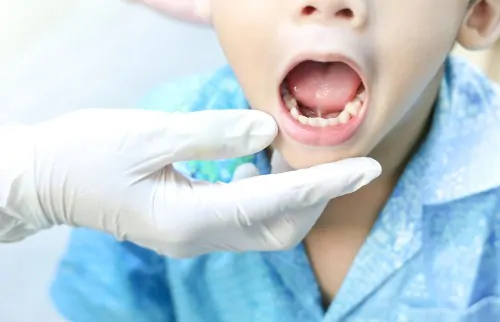
According to a study published by The National Center for Biotechnology Information, 4% to 11% of newborns have something called tongue-tie. Tongue-tie may lead to problems with breastfeeding, speech development or the ability to eat later in life. Tongue-tie is a concern for your pediatric dentist in Spring, so let’s take a closer look at what exactly tongue-tie is, what causes it, as well as treatment options.
While this condition sounds like there is a giant knot in the tongue, that’s not really the case. The area of the tongue affected by tongue-tie is that thin piece of tissue underneath the tongue known as the lingual frenulum. Babies who are born with tongue-tie have a lingual frenulum that’s either too tight, too short, or attached to the wrong area of the underside of the tongue. This can limit the tongue’s movement. A tongue without the limitation of tongue-tie can move all around the mouth, which helps to speak properly, swallow food, and swipe out pieces of food that may get left behind. All of these things that are capable with a normal tongue can be impossible or very difficult for those with tongue-tie. That’s why many times the treatment of tongue-tie is recommended by either your pediatrician or pediatric dentist in Spring.
Doctors and researchers aren’t totally sure what causes tongue-tie. What we do know is that what’s supposed to happen during development in the womb, doesn’t. Normally, the lingual frenulum grows and separates from the underside of the tongue. In tongue-tie babies, this doesn’t occur. Some medical professionals and studies suggest that it may run in families, but there’s no conclusive evidence of this. However, research does show that baby boys are three times more likely to have tongue-tie than baby girls.
The truth is, tongue-tie may not be something that’s automatically looked for in each and every baby. This makes it important to know the signs so you can seek a proper diagnosis and treatment if you suspect a problem. Some of the common signs of tongue-tie are noticed during breastfeeding and some are not. Symptoms can include:
Many times treatment of tongue-tie will be recommended. However, not always. There’s no concrete consensus as to when tongue-ties should be corrected, either. Some doctors believe it should happen sooner rather than later, while others think it’s ok to wait as tongue-tie can resolve on its own. If treatment is recommended, it will often come in two forms: a frenectomy or a frenuloplasty.
If you recognize any of the signs or symptoms of tongue-tie, talk with your pediatric dentist in Spring or pediatrician.
According to a study published by The National Center for Biotechnology Information, 4% to 11% of newborns have something called tongue-tie. Tongue-tie may lead to problems with breastfeeding, speech development or the ability to eat later in life. Tongue-tie is a concern for your pediatric dentist in Spring, so let’s… Read More…